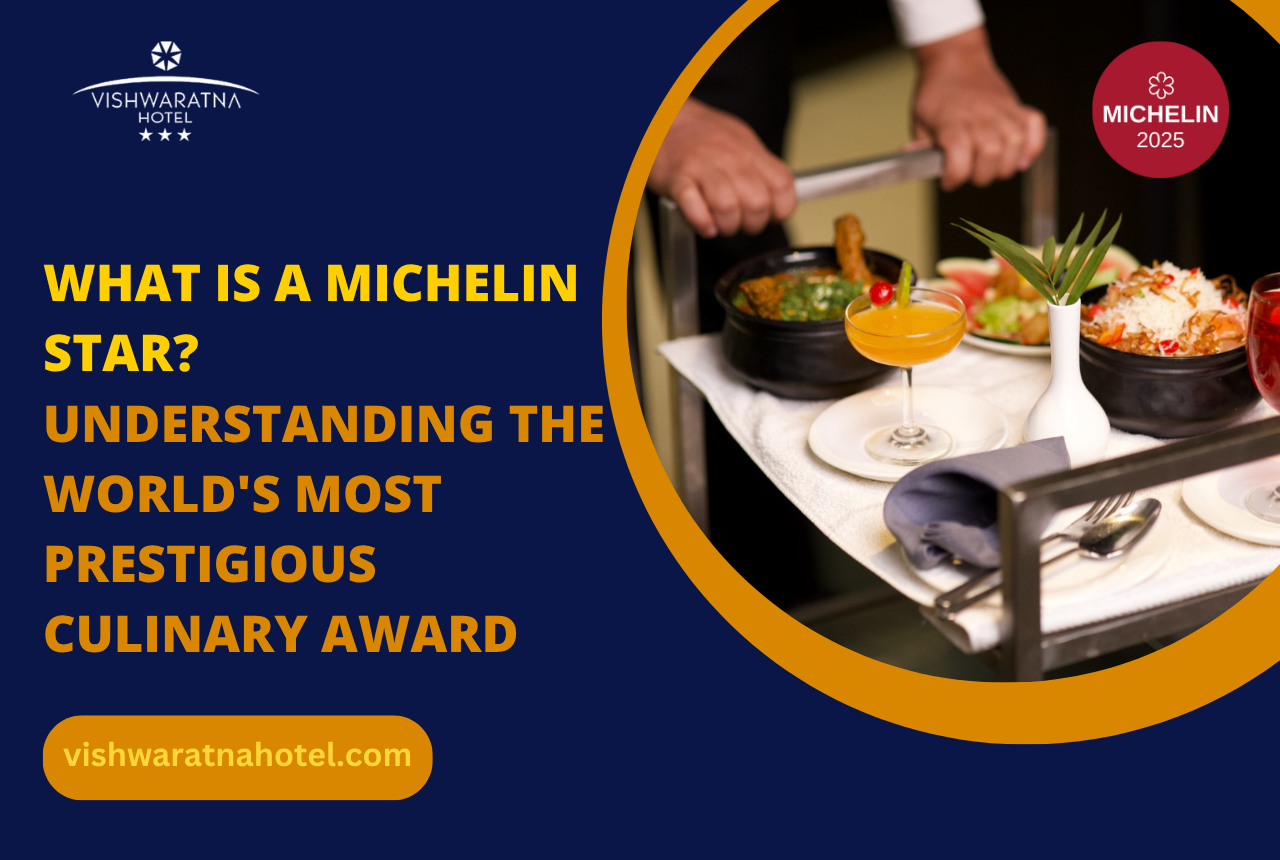When you hear the term “Michelin star,” you’re hearing about one of the most prestigious honours in the culinary world. But what exactly is a Michelin star, and why do chefs and restaurants around the globe dream of earning this distinction? Whether you’re a food enthusiast planning your next fine dining experience or simply curious about what makes certain restaurants stand out, understanding the Michelin star system opens up a fascinating world of culinary excellence.
A Michelin star is an annual award given by the Michelin Guide to restaurants that demonstrate exceptional cooking quality. Far from being just another restaurant rating, earning a Michelin star represents the pinnacle of culinary achievement, requiring unwavering consistency, technical mastery, and creative brilliance.
The Surprising Origin Story: From Tires to Fine Dining
The connection between a tire company and restaurant excellence might seem puzzling at first, but the story behind the Michelin Guide is as compelling as the restaurants it celebrates.
In 1900, French tire manufacturers and brothers Édouard and André Michelin published the first Michelin Guide to encourage French motorists to explore their country by car. At that time, fewer than 3,000 cars existed on French roads, so the brothers created a free guidebook filled with practical information for travellers, including maps, tire repair instructions, car mechanics listings, and most importantly, places to eat and stay overnight.
The guide began charging for copies in 1922, based on the principle that “man only truly respects what he pays for,” and the brothers recruited anonymous restaurant inspectors to visit and review establishments. This marked the beginning of professional restaurant criticism as we know it today.
The star rating system was introduced in 1926, initially awarding only a single star to fine dining establishments. In 1931, the hierarchy expanded to include zero, one, two, and three stars, and by 1936, the criteria for these rankings were officially published.
Decoding the Michelin Star Rating System
Understanding what each star level represents helps diners appreciate the distinction and guides aspiring chefs toward their goals.
One Michelin Star: High-Quality Cooking, Worth a Stop
One Michelin Star is awarded to restaurants using top quality ingredients, where dishes with distinct flavors are prepared to a consistently high standard. Earning even a single star is a remarkable achievement that sets a restaurant apart from thousands of competitors. These establishments demonstrate solid technique, quality ingredients, and reliable execution that makes them worth seeking out.
Two Michelin Stars: Excellent Cooking, Worth a Detour
Two Michelin Stars are awarded when the personality and talent of the chef are evident in their expertly crafted dishes; their food is refined and inspired. At this level, restaurants showcase distinctive culinary vision, advanced techniques, and memorable flavour combinations that justify going out of your way to experience.
Three Michelin Stars: Exceptional Cuisine, Worth a Special Journey
Three Michelin Stars is the highest award, given for the superlative cooking of chefs at the peak of their profession; their cooking is elevated to an art form and some of their dishes are destined to become classics. According to the 2024 Michelin Guides, only 145 restaurants worldwide hold three Michelin stars, making this the rarest and most coveted recognition in the culinary world.
The Five Sacred Criteria: What Michelin Inspectors Really Look For
Michelin awards stars based on five universal criteria evaluated identically around the world: the quality of the ingredients, the harmony of flavours, the mastery of techniques, the personality of the chef as expressed through their cuisine, and consistency both across the entire menu and over time.
Quality of Ingredients
Great cooking starts with exceptional ingredients. Inspectors look for restaurants that source the finest, freshest ingredients available, whether that means local seasonal vegetables, sustainably caught seafood, or carefully aged meats. The focus isn’t solely on expensive ingredients like truffles or caviar; perfectly prepared local carrots or artisanal bread can equally impress.
Mastery of Flavor and Cooking Techniques
Technical excellence separates good cooking from great cooking. Michelin inspectors assess whether chefs demonstrate complete control over cooking methods, whether they can balance flavors harmoniously, and whether dishes show precision in execution.
Personality of the Chef
The personality of the chef as expressed through their cuisine is a critical factor. Inspectors look for originality, creativity, and a distinctive culinary voice that makes the restaurant’s food memorable and unique.
Harmony of Flavors
Beyond individual components, dishes must work as cohesive experiences. Flavors should complement rather than compete, creating balanced compositions that delight the palate.
Consistency
Perhaps the most challenging criterion is consistency. Restaurants must maintain the same high standard of cooking across their entire menu and over time. Inspectors visit establishments multiple times, at different times of day and across seasons, to ensure this reliability.
What Doesn’t Matter for Michelin Stars (And What Does)
A common misconception about Michelin stars relates to what factors actually influence the rating.
A Michelin Star is awarded for the food on the plate – nothing else. The style of a restaurant and its degree of formality or informality have no bearing whatsoever on the award. This means that inspectors don’t consider interior décor, table settings, or even service quality when deciding whether to award stars.
That said, exceptional Michelin-starred restaurants typically do offer outstanding service and ambiance alongside their remarkable cuisine. These elements contribute to the overall dining experience, even if they don’t factor into star decisions.
Stars are awarded to restaurants, not individual chefs. This distinction matters because it means that even if a head chef leaves, the restaurant can maintain its stars if the kitchen team continues producing the same quality of food.
The Anonymous Inspectors: Guardians of Culinary Standards
The mystique surrounding Michelin inspectors adds to the prestige of the award. Michelin inspectors visit restaurants anonymously, and they award one, two, or three stars for those considered at least very good.
These inspectors are culinary professionals with extensive hospitality industry experience. They book tables, dine, and pay for their meals just like regular guests, ensuring objective evaluations. All inspectors are sent around the world to eat in countries where Michelin Guides are published, ensuring that all inspectors judge by the same standards and have the same reference points.
This global consistency means that a Michelin star in Tokyo carries the same weight and significance as one in Paris, New York, or Mumbai.
Beyond Stars: Bib Gourmand and Michelin Recommended
While Michelin stars receive the most attention, the Guide recognizes culinary excellence in other ways too.
Bib Gourmand
The Bib Gourmand, named after Bibendum (the friendly Michelin Man), is an esteemed rating that recognizes friendly establishments that serve good food at moderate prices. Originally, restaurants were flagged with a red “R” symbol to indicate they served “good cuisine at reasonable prices,” specifically a three-course meal with starter, main course and dessert within a fixed price range.
Michelin Recommended
Restaurants featured in the Michelin Guide but without stars or Bib Gourmand designations still earn the distinction of being “Michelin Recommended.” This recognition indicates that inspectors consider the establishment worthy of inclusion, which alone represents significant achievement.
Michelin Stars in India: A Growing Presence
While India itself doesn’t yet have Michelin Guide coverage, Indian cuisine has gained remarkable recognition globally through talented chefs opening restaurants in cities where the Guide operates.
Chef Vineet Bhatia opened ‘Zaika’ in the UK in 1999 and was awarded the Michelin Star in 2001, becoming the first Indian chef and proprietor to receive the honour. His second venture ‘Rasoi by Vineet’ at Mandarin Oriental, Geneva was also bestowed with a Michelin star in 2009, making him the second British chef to hold Michelin stars in more than one country.
Chef Vikas Khanna opened Junoon in Manhattan’s Flatiron district in late 2010, and the restaurant received its first Michelin star in 2011, maintaining this distinction for six consecutive years. His success helped elevate the profile of modern Indian cuisine on the global stage.
Chef Garima Arora opened her restaurant ‘Gaa’ in Bangkok in April 2017 and received a Michelin star in November 2018, with World’s 50 Best Restaurants naming her Asia’s Best Female Chef in February 2019. She holds the distinction of being the first female Indian chef to receive a Michelin star.
Currently, there are approximately 17 Michelin-starred Indian restaurants worldwide, spanning the UK, UAE, USA, and Asia, with outstanding examples in London (Gymkhana, Benares, Quilon), New York (Semma), Chicago (Indienne), Washington D.C. (Rania), and Dubai (Avatara).
The Impact of Earning a Michelin Star
For restaurants, earning a Michelin star can be transformative. The recognition typically brings increased reservations, higher prices, media attention, and enhanced prestige. However, it also comes with pressure to maintain the standards that earned the star in the first place.
Michelin continuously reassesses existing Star restaurants to ensure the same high standard of cooking is being offered to guests. Restaurants can lose stars from one year to the next if quality declines, making consistency not just important for earning stars but also for keeping them.
For chefs, a Michelin star represents career validation and can open doors to television appearances, cookbook deals, consulting opportunities, and the ability to expand their culinary empires.
How to Experience Michelin-Starred Dining
Planning your first Michelin-starred meal can feel intimidating, but these restaurants exist to provide memorable experiences, not to make guests uncomfortable.
Many Michelin-starred restaurants offer tasting menus featuring multiple courses designed to showcase the chef’s culinary vision. These typically range from five to twelve courses, with reduced portion sizes so you can enjoy the full experience without becoming uncomfortably full.
Reservations are often required well in advance, especially for two and three-star establishments. Most restaurants maintain websites with online booking systems, making the reservation process straightforward.
Dress codes vary by restaurant, but “smart casual” works for most one-star establishments, while two and three-star restaurants may expect more formal attire. When in doubt, check the restaurant’s website or call ahead.
Why Vishwaratna Hotel Appreciates Culinary Excellence
At Vishwaratna Hotel in Guwahati, we share the Michelin Guide’s commitment to culinary excellence and exceptional dining experiences. While our 3-star hotel may not pursue Michelin stars, we understand the principles that make great restaurants succeed: quality ingredients, skilled preparation, consistent standards, and genuine hospitality.
Our Multi-Cuisine Restaurant serves exquisite vegetarian and non-vegetarian dishes prepared by skilled chefs who bring passion and precision to every plate. We believe that memorable dining experiences don’t require Michelin stars—they require care, quality, and a genuine desire to delight our guests.
Whether you’re seeking contemporary Indian cuisine, international favorites, or traditional regional specialties, our restaurant offers the kind of thoughtful cooking and warm service that makes every meal special.
The Future of Michelin Stars
The Michelin Guide now covers 37 countries across Europe, Asia, North America, and South America, and it continues expanding to new territories each year. The guide has also introduced innovations like the Green Star, which recognizes restaurants committed to sustainable gastronomy.
As culinary landscapes evolve, the Michelin Guide adapts while maintaining its core mission: identifying and celebrating exceptional cooking wherever it exists. From street food-inspired establishments to avant-garde fine dining, the diversity of Michelin-starred restaurants reflects the rich variety of global cuisine.
Conclusion: More Than Just a Rating
Understanding what a Michelin star is reveals that it represents far more than a simple restaurant rating. It’s a recognition of culinary mastery, creative vision, technical excellence, and unwavering consistency. Whether you’re planning to visit a Michelin-starred restaurant or simply appreciate great food, knowing the story and standards behind these coveted awards enriches your understanding of the culinary world.
The next time you see that Michelin star designation, you’ll know it represents countless hours of preparation, years of skill development, rigorous anonymous inspections, and a commitment to excellence that places that restaurant among the finest in the world. That’s what makes a Michelin star so special—and so worth celebrating.


